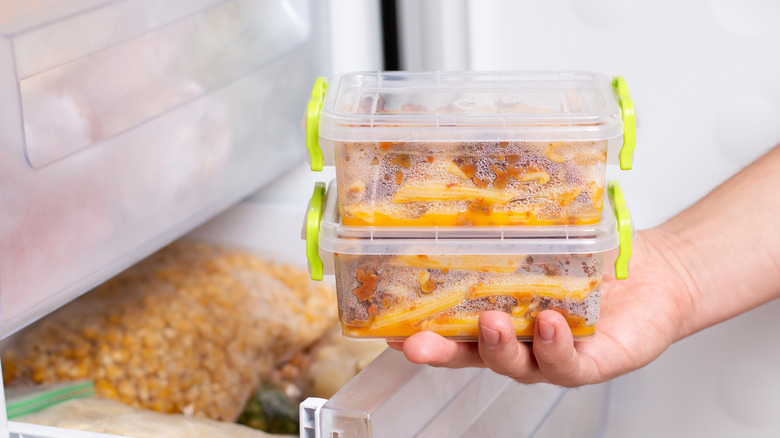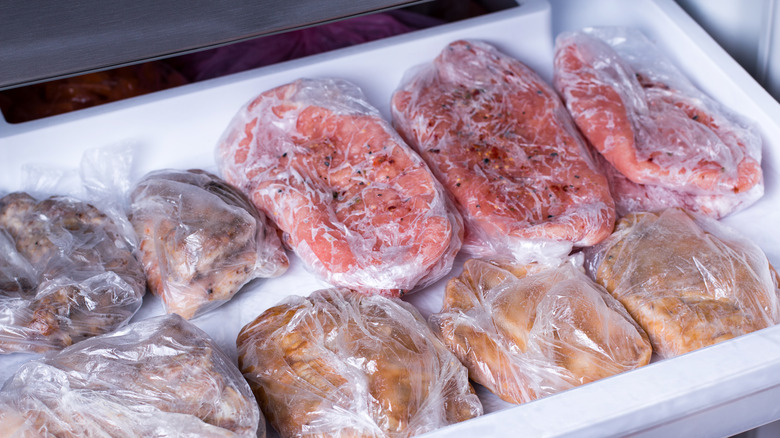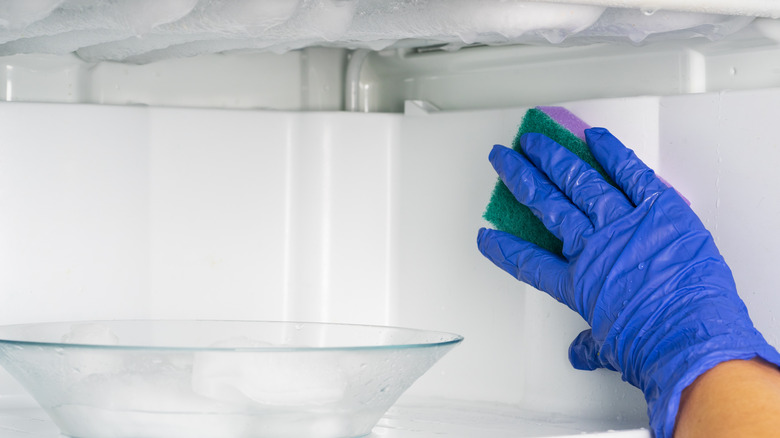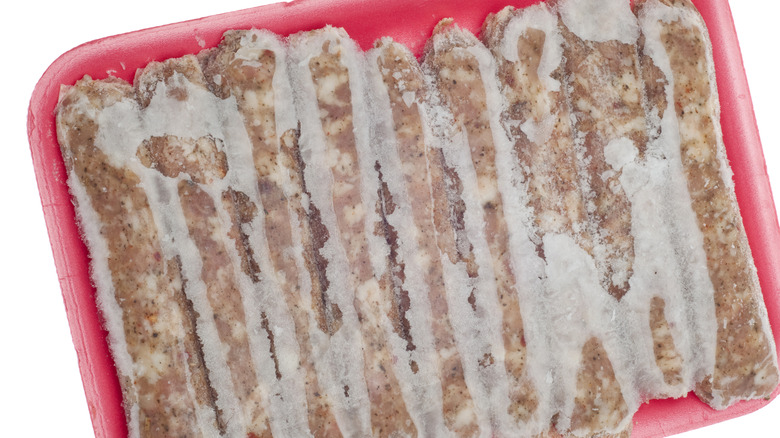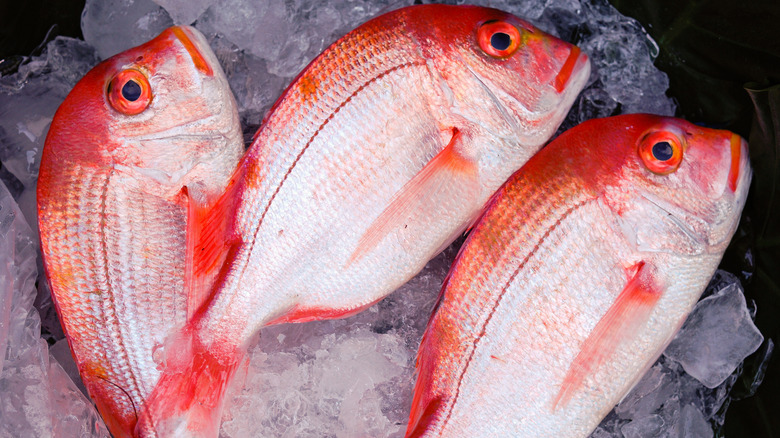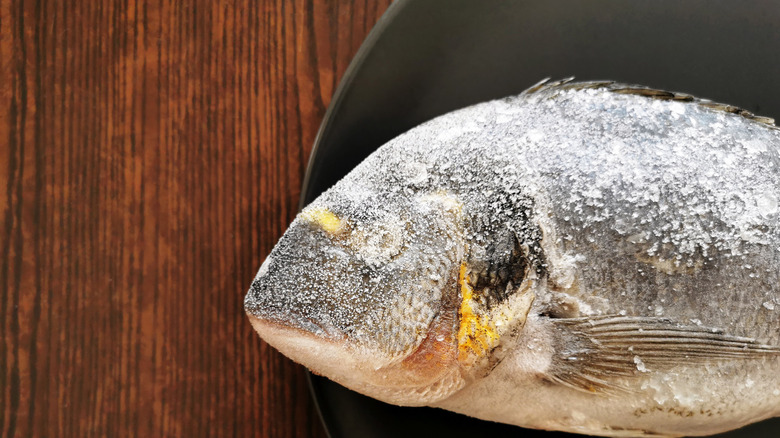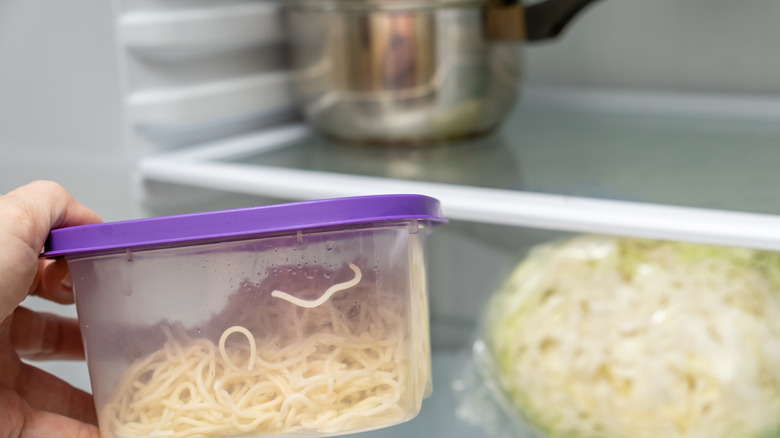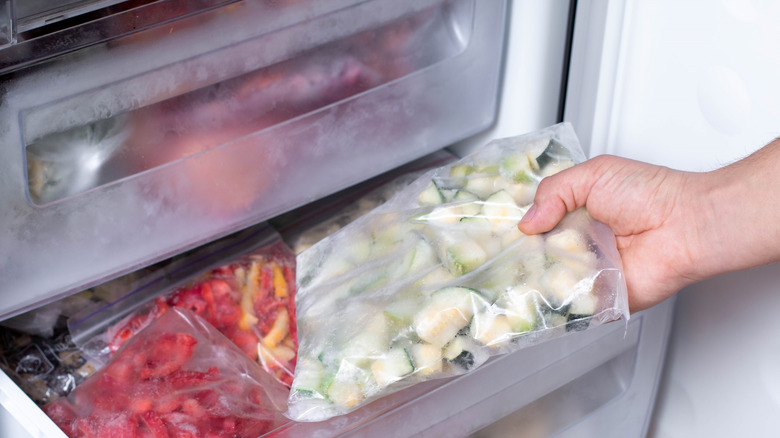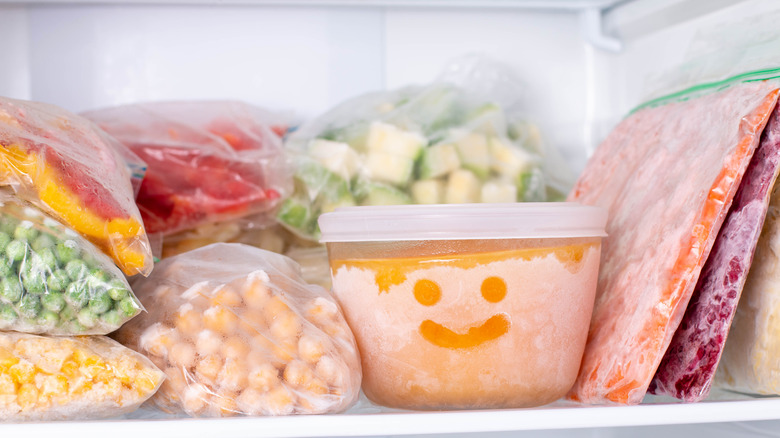Signs You Should Throw Away That Frozen Food
There's a whole lot to love about our freezers. From allowing us to cook big batches of food and freeze portions for busy nights, to the ability to bulk-buy proteins and vegetables at value prices and have them in stock for weeks or months, the freezer is an essential part of maintaining our budgets and keeping our families healthy and well fed.
Part of the draw of a freezer is that food can be stored for a very long time. But, of course, there's a limit to even a deep freeze's ability to keep food at its top quality and condition. So at what point is food in the freezer no good anymore? And how will you know if it isn't? It turns out there are some really major red flags that will let us know if our leftovers, meats, or vegetables need to be tossed. So from texture to color to smell, here are the signs you should throw away that frozen food.
That food has been in there a long time
Food can stay in the freezer for a long time, but not forever. "If you notice your frozen vegetables are losing their bright color and possibly taking on ice crystals, this is a sign they should be thrown out," Lisa Richards, a nutritionist, author, and creator of The Candida Diet, told Mashed. The loss of color doesn't indicate that the food is necessarily unhealthy or unsafe, but it could point to a loss of quality.
Meanwhile, according to the USDA, meat can be safely frozen indefinitely at 0 degrees Fahrenheit, but the quality of the frozen meat will also deteriorate. Head chef and recipe creator Jessica Randhawa of The Forked Spoon told Mashed, "Meats will slowly lose their original qualities and change color in the freezer due to freezer burn, oxidation, or by extended storage times."
That's why the USDA made a freezer storage chart of maximum length of time you should freeze meat and eggs to maintain optimal quality. But that requires a bit of planning. "This starts with adequately labeling meats when initially storing them in the freezer to properly utilize the USDA chart well and know when it's time to consider throwing it out," said Randhawa.
Another telltale sign it's time to ditch your frozen food is when it's years past its best by date. Again, while it would still be safe to eat, it'll most likely have diminished in quality and flavor.
You've lost power
Whether caused by a snowstorm, hurricane, blackout, or a local power problem, outages happen. And when they do, the quality of what's in your freezer can sometimes go downhill.
Once that meat defrosts, simply freezing it again is not that easy — and might not be the safe way to go. If you don't have a backup electricity solution and your meats in the freezer have fully defrosted above 40 degrees for more than two hours, the USDA recommends throwing away that meat. Otherwise, bacteria can grow on the meat that won't be killed off by cooking, which can lead to you getting sick.
In case of an outage, you also need to make sure your food was safely stored. "Make sure that the meat juices did not leak onto other foods in the freezer," said Randhawa. Any food in the defrosted freezer should immediately be thrown out if it's been contaminated with any meat juice — it's just not worth the risk.
Something smells funky
When opening up the freezer, there should be a blast of cold air — that's normal. But if you are blasted by something else, say a terrible odor, something might be rotten in there.
"Freezing food is really just a way to slow its decay. Although food breaks down much more slowly in the freezer than it does in the fridge or on the kitchen counter, it still decays over time," wrote Michelle Miley on Hunker.
While generally food that has turned bad is most noticeable in the fridge, this is actually possible with frozen food as well. The most obvious sign it's time to throw out your food is when it has a distinct odor or change of color. It's often tricky to know what's causing a bad odor in the freezer, unlike when there's a bad smell in the fridge, but by giving your frozen food a whiff, you should be able to find the culprit.
You see any puddles
The same way you see puddles after a snow storm as the snow starts to melt, you might see puddles in your freezer.
When opening an older freezer, it's noticeable to feel cold and see ice. Modern freezers are often frost-free (via thekitchn.com), but even with older models that accumulate frost and need to be thawed occasionally, there's really no reason there should be anything melted or liquid in there — unless, of course, something went wrong.
When you're rummaging through your freezer, discard anything that's sitting in liquid. "This is the clearest indication of a partial thaw," John Bedford, a chef and founder of Viva Flavor, told Mashed. This suggests that the temperature has been compromised, which is a good reason to throw the item out as it might no longer be safe.
Remember when dealing with anything perishable, especially proteins, it's always better to play it safe than to eat it anyway and end up sick!
It has freezer burn
There are some clear warning signs when it comes to the quality of frozen foods, and one of those signs is the presence of freezer burn. "Ice crystals on your frozen vegetables may also indicate that your food has been thawed slightly and frozen again, something that will impair taste and texture significantly," Lisa Richards, a nutritionist, author, and creator of The Candida Diet, told Mashed.
As for meat, "If there are ice crystals in the package or spots on the meat that look dry and crystallized, this is a sign of freezer burn," Kimberly Baker, a registered dietitian with a culinary degree and Clemson University's food systems and safety program team director, told us. "Freezer burn will severely impact the flavor, so look for any gray or brown spots on the surface that don't match with the overall appearance," said Bedford.
But if you're unsure if the freezer burn on your meat is caused by a lack of temperature control, then be safe and toss it. "If this meat has been thawed and left at room temperature and then refrozen, you need to throw it out," said Baker.
The texture and feel is weird
Meat that is no longer fresh will feel and look different than it did when it was at its freshest, highest quality. "Fresh meat, even after it's been safely thawed from the freezer, should never be sticky, slimy or give off odors," said Baker. If it does, it goes in the trash, not in a pan or the oven. "If there is ever any doubt of the safety of the item, then it should be thrown out," she said.
As squeamish as you might be feeling at this point, the best thing you can do is just to touch the meat and see how it feels. If the texture is off, most of the time, it's a sign that the quality has diminished rather than having to with the food's safety, but it's safe to assume that the food will likely not taste as good or have the texture you're accustomed to. But, "If the meat does not bounce back to its original shape when touched, then it should be discarded," said Baker.
Too much or too little air
Letting air get into food can be risky — but so can not letting air get in. It's kind of complicated. "Freezers do a great job of preserving food, and it's tempting to just put food in there when you don't want to use it immediately, but it's well worth it to take a moment to check out how it's packaged before you freeze," Lan Lam, senior editor at Cook's Illustrated, told Eat This, Not That.
When a food requires temperature control, i.e. in a freezer, and the required temperature has not been held (which could happen if a freezer is not cold enough or got too warm at some point), it can become a safety issue. "The air can transport pathogens, spoiling the milk since it is not being kept cold," said Baker. That's why it's important that items in the freezer are well wrapped or in airtight containers.
The color has changed
Fish shouldn't change in color much when frozen, but if your fish starts to look more gray or off-putting, it's a sign that quality is diminishing. It should still be safe to eat if safely stored, says the USDA, but, as always, if you're not sure, throw it out.
While meat might start out a bright red color when we pick it up at the butcher or supermarket, it can ultimately turn to a darker color or even a pale brown as time goes on. This is less about the meat spoiling as about a lack of oxygen, freezer burn, or just being stored in the freezer a really long time. While this isn't dangerous or a sign the meat is spoiled, either, it's not going to be its best quality.
As for vegetables, they can also get duller in color, which isn't less safe, but is an indication that quality has diminished.
Unidentifiable frozen food
If food you've cooked or bought that doesn't have a best by date has been in the freezer for so long that you have no idea what it is or how long it's been there, then it's time for that food to get tossed. Don't take risks with food when you cannot identify why a change has occurred, whether it's the way it looks, smells, or feels.
Of course, this is only a problem if you have no idea how long anything has been there. That's why it's always a good idea to put a label on your food before freezing it. "Label and date everything you freeze so you're sure what it is and how old it is," Lam told Eat This, Not That. The label on the container or package should include what the food is and when it was frozen. That way when it's time to go, it'll be a clear decision with no guessing games!
The freezer is overcrowded
While it's fine to pack the freezer with proteins and leftovers, you don't want to overload it. Much like a pot that is too full, if a freezer is too crowded, it won't be able to do its job as well.
"Overfilling the freezer can block air vents, restrict the flow of cold air, and overtax your refrigerator's condenser, which could lead to a burn out. An overcrowded freezer puts strain on the motor," wrote Jennifer Noonan on Bob Vila's website. So if there's too much stuff in the freezer, it might be a good time to clean it out and get rid of that old and unidentifiable stuff — and to make room for the food you want to keep around for a while.
Baker also notes that unfrozen foods put into an overcrowded freezer take longer to reach the freezing point, "possibly compromising them from a quality and safety standpoint," she says. "This is particularly of concern if the food put into the freezer is hot, because food needs to be able to drop below 40 degrees within six hours, and an overcrowded freezer can extend the necessary cool-down period, causing pathogens to begin growing within the food."
When in doubt, throw it out
Eating spoiled food can be very unhealthy — and even deadly. If there's any doubt as to whether food is still safe to eat, it's best to err on the side of caution and throw it out. And tasting it first is not a good idea either. Just a little bit could be enough to make you sick.
"Never taste food to determine if it's safe or depend on appearance or odor. Food in the freezer that still has ice crystals can be refrozen or cooked, but better to toss it out if you're unsure. Eating food not kept at the proper temperature may cause illness even if it is thoroughly cooked," Bob Gravani, Ph.D. and Professor of Food Science at Cornell University, told Mashed.
No one wants to throw away food, but no one wants to get sick either. So say it with us: When in doubt, throw it out.
